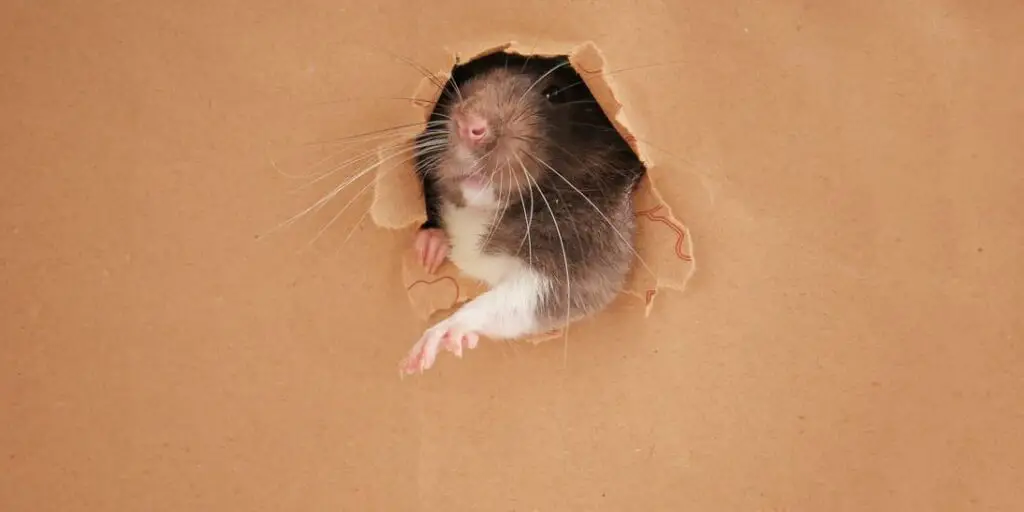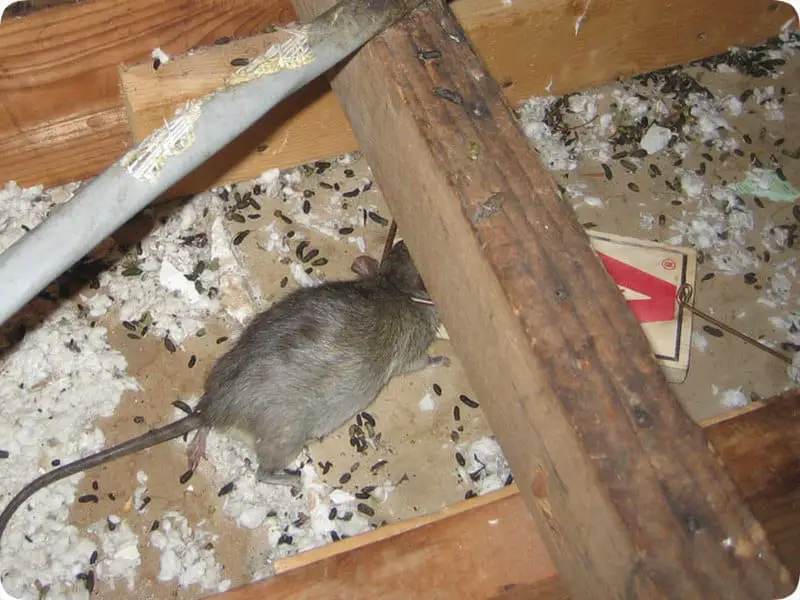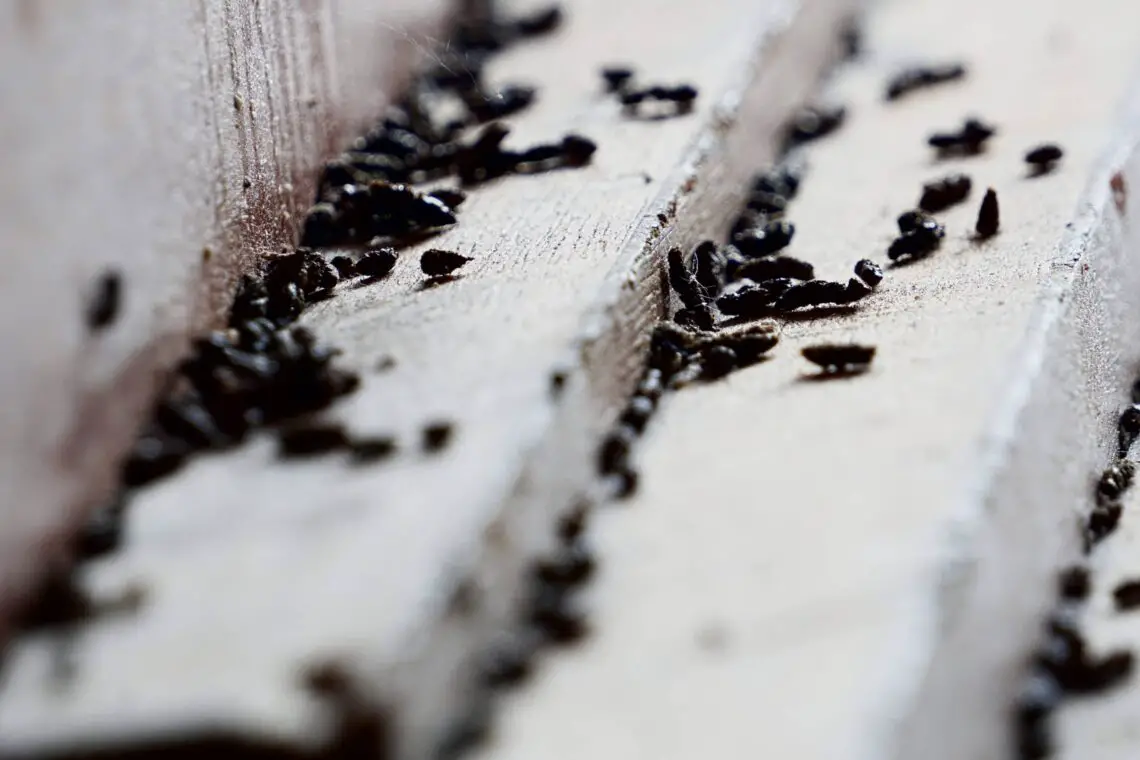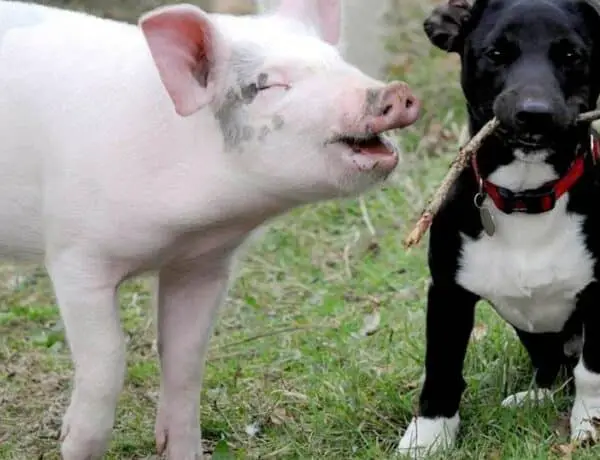Introduction
What Do Rat Droppings Look Like: Rat droppings serve as a crucial indicator of rodent infestations and can provide valuable insights into the severity of the problem. These small, pellet-like excrements are typically dark brown or black in color and have a tapered, elongated shape. They resemble grains of rice but are larger, with an average length of around half an inch.
The size and appearance of rat droppings can vary depending on the species and age of the rat, as well as its diet. Fresh droppings tend to be moist and shiny, gradually drying and becoming harder over time. Identifying these distinctive pellets is essential for homeowners and pest control professionals to take prompt action in addressing rat infestations and minimizing health risks associated with their presence.
In this guide, we will explore the characteristics of rat droppings in detail, helping you recognize and differentiate them from other similar pests’ feces, such as mice. Additionally, we will discuss the importance of proper cleanup and prevention measures to maintain a pest-free environment.

How do you identify rat droppings?
Rat droppings tend to be found in a large grouping, and the droppings are of similar shape and size to an olive – around half an inch. They’re often found near or around property insulations.
Mouse droppings, in comparison, are much smaller and similar to the size of a small berry or raisin.
Identifying rat droppings is a crucial skill when dealing with potential rodent infestations in homes, businesses, or other areas. Rat droppings are distinctive in appearance, and recognizing their characteristics can help individuals take appropriate measures to address the presence of these unwanted pests. One of the primary ways to identify rat droppings is through their size and shape. They are typically small, elongated pellets, roughly measuring between 1/2 to 3/4 of an inch in length. Their shape is similar to that of a grain of rice, with pointed ends, which sets them apart from the droppings of other animals.
Another important aspect of identifying rat droppings is their color. Fresh rat droppings are usually dark brown or black, although this can vary depending on the rat’s diet. The color tends to be darker when the droppings are fresh and becomes lighter as they age. Over time, rat droppings may even turn gray and crumble, which can be a sign of older or dried droppings. This color change is a helpful clue for differentiating rat droppings from those of other rodents or animals that may share a similar size and shape.
In addition to their size, shape, and color, the location where rat droppings are found can be a crucial factor in their identification. Rats tend to leave droppings in specific areas, often along well-traveled routes or near their nests and feeding sites. Common places to find rat droppings include basements, attics, crawlspaces, kitchen cabinets, and hidden corners. Frequent inspection of these areas, especially in places where food is stored or where rats are likely to seek shelter, can help in the early detection of a rat infestation and prompt action to address the issue.
Is rat feces harmful?
Anyone who comes into contact with infected rodent droppings, urine, saliva, nesting materials, or particles from these, can get hantavirus disease. Exposure to poorly ventilated areas with active rodent infestations in households is the strongest risk factor for infection.
The Health Risks of Rat Feces:
Rat feces, like the droppings of many other rodents, can pose significant health risks to humans. This is primarily due to the potential transmission of diseases through contact with contaminated droppings. Rats are known carriers of various pathogens, and their feces can harbor harmful bacteria and viruses that may cause serious illnesses. When rat droppings are left unchecked in living spaces, commercial buildings, or food storage areas, they can become a breeding ground for disease, making it crucial to address rat infestations promptly.
Disease Transmission:
One of the most concerning aspects of rat feces is the potential transmission of diseases to humans. Rats are known to carry diseases such as leptospirosis, hantavirus, and salmonellosis. When rats defecate in areas where humans live or work, there is a risk of these pathogens being present in their droppings. If individuals come into contact with rat feces, either directly or indirectly through contaminated surfaces, they can become infected. For example, the hantavirus can be contracted through inhaling dust particles contaminated with rat droppings, particularly in enclosed spaces where the droppings have dried and become airborne. Similarly, contact with rat feces in food storage areas or kitchens can lead to the spread of diseases like salmonellosis, which causes food poisoning.
Allergic Reactions and Respiratory Issues:
Beyond the direct transmission of diseases, rat feces can also trigger allergic reactions and respiratory problems in some individuals. This is particularly true when rat droppings dry and crumble, releasing particles into the air. These particles can contain allergenic proteins, which, when inhaled, may lead to symptoms such as sneezing, coughing, wheezing, and itchy eyes. Individuals with preexisting respiratory conditions, such as asthma, may be especially vulnerable to the airborne allergens present in rat feces. Furthermore, the dust from dried rat droppings can contain bacterial components that irritate the respiratory system, potentially exacerbating respiratory issues in susceptible individuals.
How does rat poop look?
Rat feces are black while Squirrel feces are grey or are sometimes black. Squirrel feces are often referred to as “mushroom” feces, due to their ‘toadstool’ like appearance. They are usually found in cluttered areas – they are most commonly found on rooftops, in attics, and in garages.
Color:
The color of rat droppings is another distinguishing feature. Fresh rat droppings tend to be dark brown to black in color, which may vary depending on the rat’s diet. Rats are opportunistic feeders, so their diet can encompass a wide range of foods, influencing the color of their droppings. These fresh droppings are often moist and somewhat soft in texture.
As rat droppings age, they gradually lose their moisture content and darken further. Over time, they may become gray and eventually crumble. This aging process can make it more challenging to identify rat droppings, as they may resemble other small, dry debris.
Quantity and Location:
The presence and quantity of rat droppings in an area can also provide clues about the extent of a rat infestation. Rats typically defecate numerous times a day, so a heavy rat infestation can result in a significant accumulation of droppings. You may find rat droppings concentrated in specific areas where rats frequently travel, nest, or feed. Common locations for finding rat droppings include dark corners, hidden spaces, near food sources, and along walls or baseboards.
Health Risks:
Recognizing and promptly addressing rat droppings is not only about pest control but also a matter of health and safety. Rat droppings can pose serious health risks to humans. Rats are known vectors for diseases such as leptospirosis, hantavirus, and salmonellosis, and their feces can contain these pathogens. Handling or disturbing rat droppings without proper precautions can lead to the spread of these diseases through contact with contaminated surfaces or inhalation of airborne particles.
How long do rat droppings last?
Droppings as fresh as 48 to 72 hours will start to look faded and old. The squish test can help differentiate old from new droppings. Rodent droppings tend to be black, but can be brown, green or other colors. The droppings will take on the color of what they are feeding on such as rodenticide bait.
The longevity of rat droppings, also known as rodent feces, can vary depending on several factors, including environmental conditions and the age of the droppings. Understanding how long rat droppings can last is essential for both identifying the presence of rodents and managing potential health risks associated with them.
Freshness and Moisture:
The freshness and moisture content of rat droppings play a significant role in determining their lifespan. Fresh droppings are typically dark brown or black and have a moist, slightly soft texture. These are the most common indicators of an active rat infestation. Fresh droppings are more likely to retain their shape and characteristics for a more extended period, especially if they remain in a dry environment.
Aging Process:
As rat droppings age, they undergo changes in color, texture, and durability. Initially dark and moist, fresh droppings gradually lose moisture and begin to dry out. Over time, they become lighter in color, turning from dark brown to gray, and eventually, they may crumble or break apart. The aging process of rat droppings can vary from a few weeks to several months, depending on factors such as humidity, temperature, and the presence of other materials that can affect their decomposition.
Environmental Factors:
Environmental conditions significantly impact the longevity of rat droppings. In a dry and well-ventilated environment, rat droppings tend to dry out faster and may become brittle, ultimately disintegrating more quickly. Conversely, in a damp or humid environment, droppings can retain their moisture and structural integrity for a more extended period, potentially harboring pathogens and contributing to a longer-lasting problem.
Do rats leave droppings everywhere?
Rats tend to leave their droppings in one place, so if you find one drop, there will probably be more nearby. Look for signs that rats may have been in the area recently: small holes in walls or floors, chewed up food containers, or shredded paper products (like books).
Rats and Their Dropping Habits:
Rats are prolific when it comes to producing droppings. They are known to leave droppings along their travel routes, which often include baseboards, walls, and corners. Rats tend to be creatures of habit, following specific paths as they move through their environment. Consequently, you may find concentrated areas of droppings along these pathways, giving the appearance that they are indeed left “everywhere.”
Nesting Areas and Droppings:
Rats create nests where they rest, reproduce, and raise their young. These nests are typically located in hidden, sheltered areas within a structure. While rats may not leave droppings directly within their nests, they do tend to scatter droppings in the vicinity. This behavior is partly due to their territorial marking instincts and partly because they may defecate while moving around their nest area.
Food Sources and Droppings:
Rats are scavengers and opportunistic feeders, which means they actively search for food in various places. As they forage for food, they may leave droppings near their food sources. Kitchens, pantries, and food storage areas are common places where rat droppings may be found, as rats are drawn to these locations in search of sustenance.
Can you touch rat poop?
Any activity that puts you in contact with rodent droppings, urine, saliva, or nesting materials can place you at risk for infection. Hantavirus is spread when virus-containing particles from rodent urine, droppings, or saliva are stirred into the air.
Touching rat poop is generally not recommended due to potential health risks associated with contact with rodent feces. Rats can carry various diseases and parasites, some of which can be transmitted to humans through contact with their droppings. In this article, we will explore the risks involved in touching rat poop and offer guidance on how to safely handle such situations.
Health Risks:
One of the primary reasons to avoid touching rat poop is the risk of disease transmission. Rats can carry pathogens, bacteria, and viruses that can be harmful to humans. One well-known disease associated with rat droppings is leptospirosis, which can cause symptoms ranging from mild flu-like illness to severe organ damage. Hantavirus is another serious concern, particularly in some regions, and it can lead to a potentially fatal respiratory illness.
Parasitic Infections:
Rat droppings can also be a source of parasitic infections. One example is the rat tapeworm, which can infest humans who accidentally ingest contaminated food or water. These parasites can lead to a range of health problems, including digestive issues and nutrient deficiencies.
Cross-Contamination:
Touching rat poop can also lead to cross-contamination. If you inadvertently touch rat droppings and then touch your face, mouth, or food, you can introduce pathogens into your body, increasing the risk of infection. Proper handwashing
and hygiene practices are essential to mitigate this risk.
Is rat poop soft or hard?
Rat poop is dark and soft when newly deposited but after a couple of days, the stool hardens and becomes lighter in colour. The droppings of a rat can be as big as ¾ of an inch long and ¼ inch thick. This being said, rat poop does vary depending on the species but it is predominantly the same long, spindle-shape.
Rat poop, also known as rat droppings or feces, can vary in texture depending on its age and moisture content. Typically, rat droppings start off as soft and moist when first excreted, gradually transforming into harder pellets as they age and dry out.
When freshly deposited, rat poop is relatively soft and may have a slightly shiny or glistening appearance due to its moisture content. This softness is because the feces are still wet, and they can easily smear or leave marks when touched. Rat droppings are often dark brown or black in color, making them stand out against lighter surfaces.
As time passes, rat droppings begin to lose moisture and dry out. They become harder and more solid in texture. The aging process can cause the droppings to lose their initial shine and appear dull. The hardness of rat droppings can vary depending on factors such as humidity levels in the environment, the rat’s diet, and the specific species of rat.
Can rat droppings make you sick?
People get HPS when they breath in hantaviruses. This can happen when rodent urine and droppings that contain a hantavirus are stirred up into the air. People can also become infected when they touch mouse or rat urine, droppings, or nesting materials that contain the virus and then touch their eyes, nose, or mouth.
Rat droppings, like those of other rodents, can indeed pose health risks to humans. These small, seemingly innocuous pellets may harbor harmful pathogens and allergens that, when handled or inhaled, can lead to various illnesses. In this article, we will delve into the potential health hazards associated with rat droppings and explore the importance of proper handling, cleanup, and prevention measures.
Hantavirus:
One of the most serious health risks associated with rat droppings is the potential transmission of hantavirus. Hantavirus pulmonary syndrome (HPS) is a rare but potentially fatal disease caused by certain strains of hantavirus. These viruses are typically carried by deer mice and cotton rats but can also be found in the droppings and urine of other rodents, including rats. When rat droppings are disturbed, tiny particles can become airborne and inhaled, potentially exposing individuals to the virus.
Leptospirosis:
Another concerning disease associated with rat droppings is leptospirosis. This bacterial infection is caused by the Leptospira bacteria, which can be found in the urine of infected rats and other animals. Humans can contract leptospirosis through contact with contaminated water, soil, or surfaces, including areas where rat droppings are present.
Allergies and Asthma:
Rat droppings can also trigger allergies and exacerbate respiratory conditions such as asthma. They contain proteins that can act as allergens when inhaled or touched. Individuals with a sensitivity to these allergens may experience symptoms like sneezing, runny nose, itchy eyes, and skin rashes when exposed to rat droppings or their dust. For those with asthma, exposure can potentially lead to worsened respiratory symptoms and increased asthma attacks.

Conclusion
Understanding what rat droppings look like is crucial for both identifying a potential rodent infestation and taking necessary steps to mitigate it. Rat droppings are typically small, dark pellets resembling grains of rice, and their appearance can vary slightly depending on the rat species. Recognizing these distinctive droppings can be the first step in addressing a rodent problem, as they serve as a clear indicator of their presence.
The presence of rat droppings poses significant health risks, as they can carry harmful pathogens that may be transmitted to humans through contact or inhalation. Therefore, it is essential to take immediate action upon discovering rat droppings in your home or workspace. Effective pest control measures, such as sealing entry points, setting traps, and maintaining cleanliness, should be implemented promptly to prevent further infestations and safeguard the health and well-being of those in the affected environment.
Identifying rat droppings is a vital skill for anyone concerned about the potential presence of rodents. Recognizing these telltale signs early can help initiate the necessary steps to address the issue promptly, ensuring a safer and healthier living or working environment.





No Comments